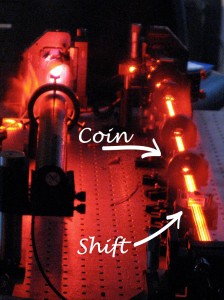Quantum Technology Lab 2010
- Post by: admin
- April 18, 2010
- 4 Comments
Our lab has had a good start into the year. First, our paper “Towards quantum chemistry on a quantum computer” appeared in Nature Chemistry. This work has received quite a lot of media attention, as chronicled by our lab website.
A short time later, we published an experiment on quantum control, “Experimental feedback control of quantum systems using weak measurements”, in the venerable Physical Review Letters (PRL).
Now, our more recent work, “Single-photon quantum walks with tunable decoherence” has gone live, also in PRL, congratulations to Matt on his first first-author paper during his PhD!

The photo on the right shows a few steps of our experiment. One step of the discrete quantum walk on a line consists of two operations – a coin operator, which controls the state of the quantum coin, and a shift operator, which acts on the quantum coin depending on its state. In our walk, we encoded the coin into the polarization of single photons. The coin operators are simple wave-plates, and the shift operators are calcite beam-displacers. One can clearly see how the beam displacer on the bottom right shifts the incoming beams and essentially adds one additional optical mode to the walk.
Hi, a question that bothered me since I’ve read your paper. I guess that if you would use a HeNe in the actual experiment, you would get the same probability distribution. If true, this means that the “quantum” walk can also be exhibited by classical light, meaning, it is a wave phenomena. if so, how can a classical effect be used for quantum computing?
That’s true, you observe the same probability distribution at the exit of the walk with a coherent light source such as a He-Ne laser. This analogy stops working, however, as soon as you add a second, or more quantum coins. You need more than one qubit to do efficient quantum computing and the same is true for a quantum algorithm recast into a quantum walk.